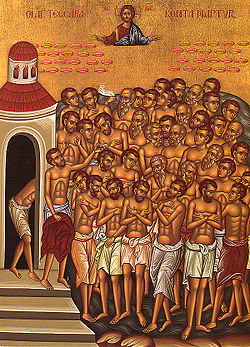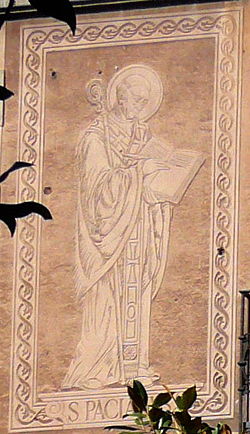Top Qs
Timeline
Chat
Perspective
March 9 (Eastern Orthodox liturgics)
From Wikipedia, the free encyclopedia
Remove ads
March 8 - Eastern Orthodox liturgical calendar - March 10

All fixed commemorations below are observed on March 22 by Orthodox Churches on the Old Calendar.[note 1]
For March 9th, Orthodox Churches on the Old Calendar commemorate the Saints listed on February 24 (February 25 on leap years).
Saints
- Martyr Urpasian the Senator, at Nicomedia, by being burned alive (c. 305)[1][2][3]
- The Holy Forty Martyrs of Sebaste (320):[1][4][5][6][note 2][note 3]
- Cyrion (or Quirio), Candidus, Domnus, Hesychius, Heraclius, Smaragdus, Eunoicus, Valens, Vivianus, Claudius, Priscus, Theodulus, Eutychius, John, Xanthias, Helianus, Sisinius, Angus, Aetius, Flavius, Acacius, Ecdicius, Lysimachus, Alexander, Elias, Gorgonius, Theophilus, Dometian, Gaius, Leontius, Athanasius, Cyril, Sacerdon, Nicholas, Valerius, Philoctimon, Severian, Chudion, Aglaius, and Meliton.
Remove ads
Pre-Schism Western saints
- Saint Pacianus, Bishop of Barcelona (390)[1][10][11]
- Saint Constantine of Cornwall and Govan (576)[10][note 4] (see also: March 11[15])
- Saint Bosa of York, Bishop of York (705)[1][10][16][17]
- Venerable Vitalis of Castronovo, Sicily (994)[1][18][note 5]
- Saint Anthony, a monk at Luxeuil in France, became a hermit in Froidemont in Franche-Comté (10th century)[10]
Post-Schism Orthodox saints
- Saint Jonah, archbishop of Novgorod (1470)[1]
- Saint Theodosius Levitsky, priest of Balta, Odessa (1845)[1]
- Saint Dimitra (Ihorova), nun and foundress of the Vvedensk (Vovedenska) Convent in Kiev (1878)[1]
New martyrs and confessors
- 42 Martyrs of Momišići, two priests and their forty students, martyred by fire by the Ottomans (1688)[1][20][21]
- New Hieromartyr Mitrophan Buchnoff, Archpriest, of Voronezh (1931)[1][22]
- New Hieromartyr Joasaph (Shakhov), Abbot, of Popovka (Moscow) (1938)[1][22]
- New Hieromartyrs (1938):[22][23][24]
Other commemorations
- Translation to Vladimir (1230) of the relics of Martyr Abraham of the Bulgars on the Volga (1229)[1]
- "Albazin" Icon of the Most Holy Theotokos ("The Word Was Made Flesh") (1666)[1][25][26][note 6]
- Repose of Elder Cleopas of Ostrov-Vvedensky Monastery (1778)[1][28][note 7]
- Repose of Schema-Archimandrite Theophilus (Rossokha) of Kiev (1996)[1][29]
Icon gallery
- The Holy Forty Martyrs of Sebaste.
- Saint Pacianus in the façade of the bishop's palace in Barcelona, Catalonia.
- St. Abraham of Bulgaria.
Notes
- The notation Old Style or (OS) is sometimes used to indicate a date in the Julian Calendar (which is used by churches on the "Old Calendar").
The notation New Style or (NS), indicates a date in the Revised Julian calendar (which is used by churches on the "New Calendar"). - We ought tentatively to regard it as probable that the saints whose lives have come down to us were really the founders of Greek monasticism in South Italy, and that before their time there were no Greek monasteries in the district. There probably were hermits; but the rise of monasteries does not begin before the end of the ninth century; and the leaders of the monks were Elias Junior (†903), Elias Spelaeotes ("the Cave-Dweller", †c. 960), Lucas of Demena (†984), Vitalis of Castronuovo (†994), and Nilus of Rossano (†1004).[19]
- The Albazin Icon of the Mother of God "the Word made Flesh" is of great religious significance in the Amur River region. It received its name from the Russian fortress of Albazin (now the village of Albazino) along the Amur river, founded in the year 1650 by the famous Russian frontier ataman Hierotheus Khabarov on the site of a settlement of the Daurian prince Albaza. For more than 300 years the Wonderworking Albazin Icon of the Mother of God watched over the Amur frontier of Russia.[27]
- See: (in Russian) Свято-Введенский Островной монастырь. Википедии. (Russian Wikipedia). -- Ostrov-Vvedensky Monastery.
Remove ads
References
Sources
Wikiwand - on
Seamless Wikipedia browsing. On steroids.
Remove ads



